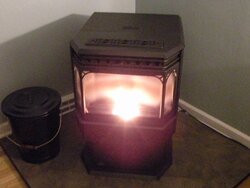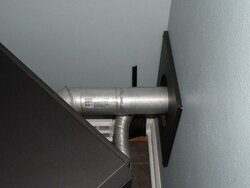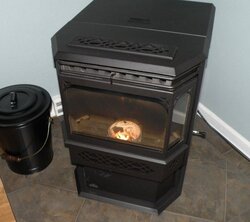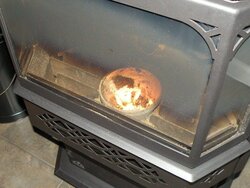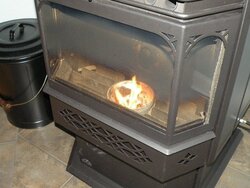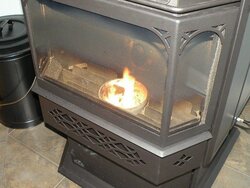Hi, Everybody!
We have a Napoleon NPS40 (freestanding) stove and this is our second season. Last season we thought we'd found the stove's "sweet spot" in terms of settings: feed setting of 4 (right in the middle of their "optimum" range) and a damper setting of 2.
Last year we had a couple of major home renovation projects going on, so if the stove was producing heat at all we were happy. We kept it clean and full and running and otherwise our time and minds and hands were occupied elsewhere in the house.
This year I'm all about optimizing our stove's performance, i.e. wringing every last btu out of those pellets.
Our Napoleon has basic, manual mechanical controls.
I've done the damper thing I saw described elsewhere on the forum- push the damper in until the flame gets big and lazy, then pull the damper out as the flame gets more compact, intense and whiter. When the flame stops changing you have, according to this explanation, found your optimum damper setting.
Our Napoleon has a horizontal exhaust vent out of the adjacent wall with one 45' elbow inside the house behind the stove and a short distance to travel to the outside. (The stove is positioned on an angle in a corner.) We have a professionally installed OAK. That OAK intake tubing also travels a very short distance. We have NO PROBLEM with an outside air feed to the burn pot. As I extract the damper rod the flame just gets tighter and tighter and whiter and whiter all the way to damper wide open. I can actually get a Bunsen burner flame with blue at the base.
So do I just stop extracting the damper rod at the point where the flame gets white and tight? Because that's actually a little lower than 2. It's more like a damper setting of 1, with "Low" being the lowest and 5 being the most wide open. Does this make sense given the above scenario?
We also use a box fan pointed at the stove to facilitate natural convection. That seems to work quite well.
Last year we burned Hamer's Hot Ones, plus several bags of Lignetics that we purchased from a private seller who didn't need them. This year we are burning O'Malleys.
I want to burn at the most efficient setting and I want to avoid sending excess heat out of the exhaust vent. Where is our damper best set and is there anything else we can do to optimize performance?
GREAT FORUM, btw. So much good information here!
We have a Napoleon NPS40 (freestanding) stove and this is our second season. Last season we thought we'd found the stove's "sweet spot" in terms of settings: feed setting of 4 (right in the middle of their "optimum" range) and a damper setting of 2.
Last year we had a couple of major home renovation projects going on, so if the stove was producing heat at all we were happy. We kept it clean and full and running and otherwise our time and minds and hands were occupied elsewhere in the house.
This year I'm all about optimizing our stove's performance, i.e. wringing every last btu out of those pellets.
Our Napoleon has basic, manual mechanical controls.
I've done the damper thing I saw described elsewhere on the forum- push the damper in until the flame gets big and lazy, then pull the damper out as the flame gets more compact, intense and whiter. When the flame stops changing you have, according to this explanation, found your optimum damper setting.
Our Napoleon has a horizontal exhaust vent out of the adjacent wall with one 45' elbow inside the house behind the stove and a short distance to travel to the outside. (The stove is positioned on an angle in a corner.) We have a professionally installed OAK. That OAK intake tubing also travels a very short distance. We have NO PROBLEM with an outside air feed to the burn pot. As I extract the damper rod the flame just gets tighter and tighter and whiter and whiter all the way to damper wide open. I can actually get a Bunsen burner flame with blue at the base.
So do I just stop extracting the damper rod at the point where the flame gets white and tight? Because that's actually a little lower than 2. It's more like a damper setting of 1, with "Low" being the lowest and 5 being the most wide open. Does this make sense given the above scenario?
We also use a box fan pointed at the stove to facilitate natural convection. That seems to work quite well.
Last year we burned Hamer's Hot Ones, plus several bags of Lignetics that we purchased from a private seller who didn't need them. This year we are burning O'Malleys.
I want to burn at the most efficient setting and I want to avoid sending excess heat out of the exhaust vent. Where is our damper best set and is there anything else we can do to optimize performance?
GREAT FORUM, btw. So much good information here!




